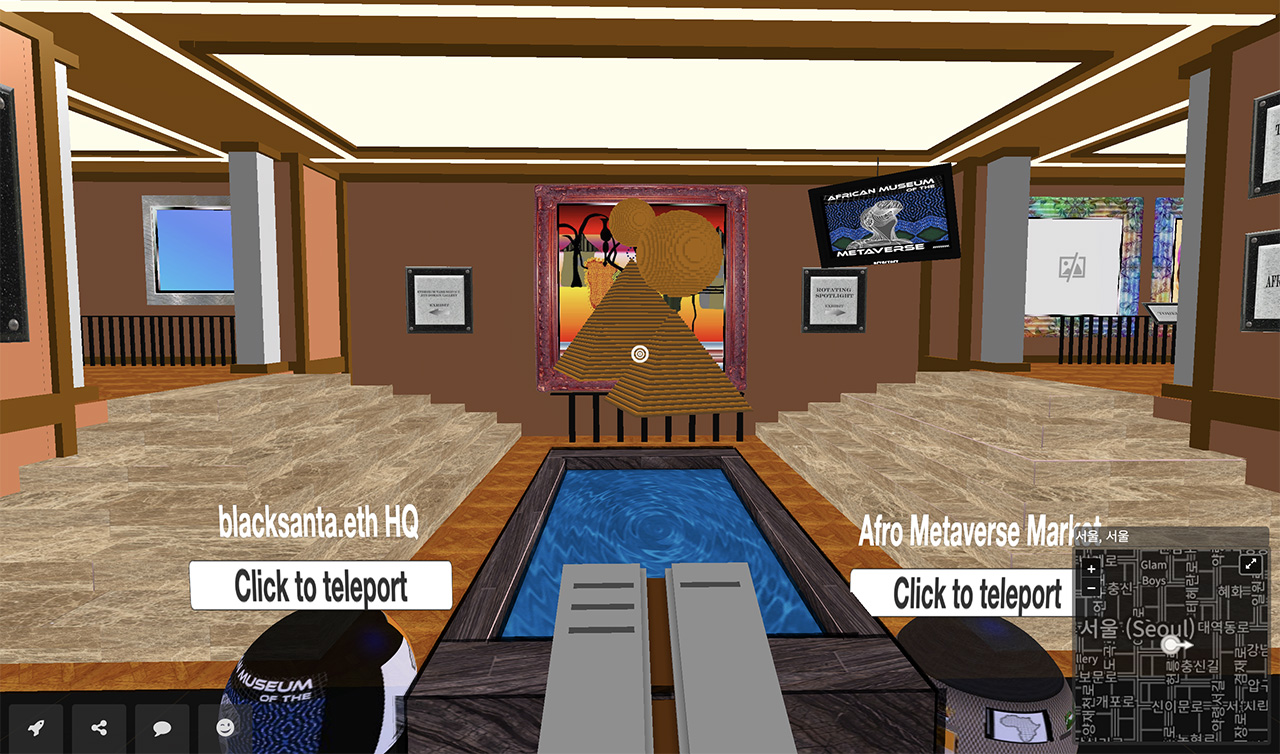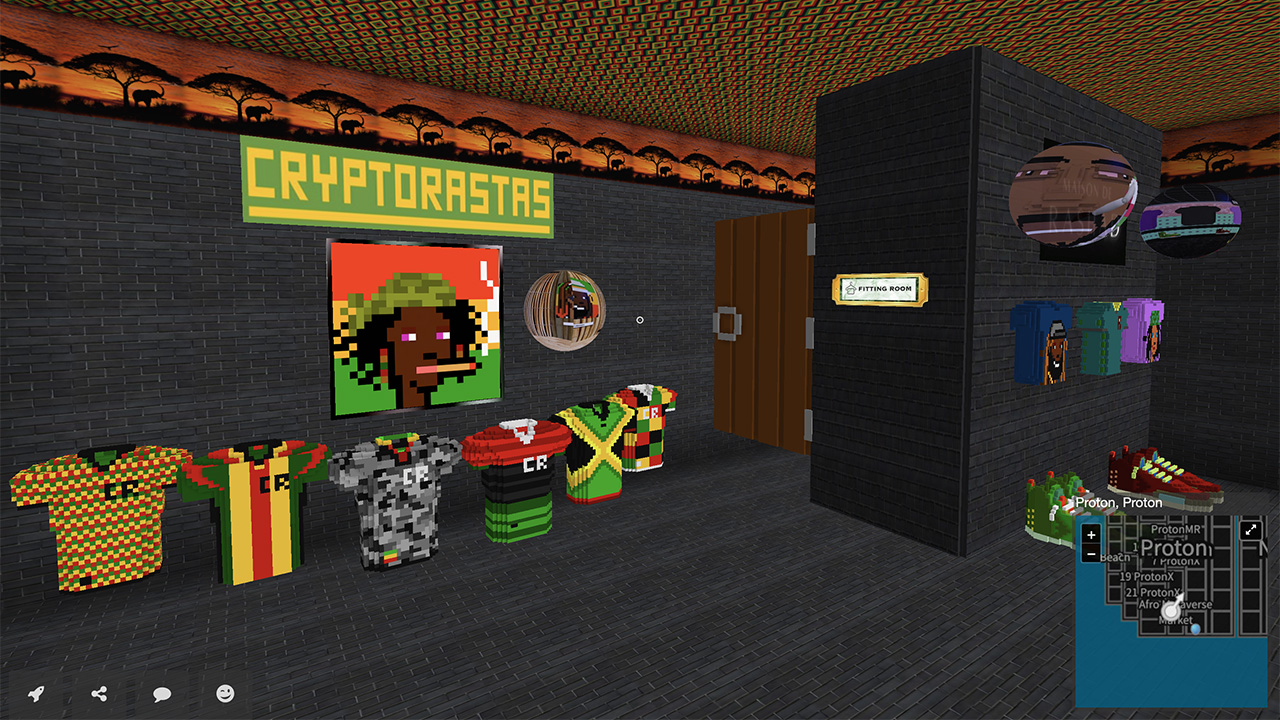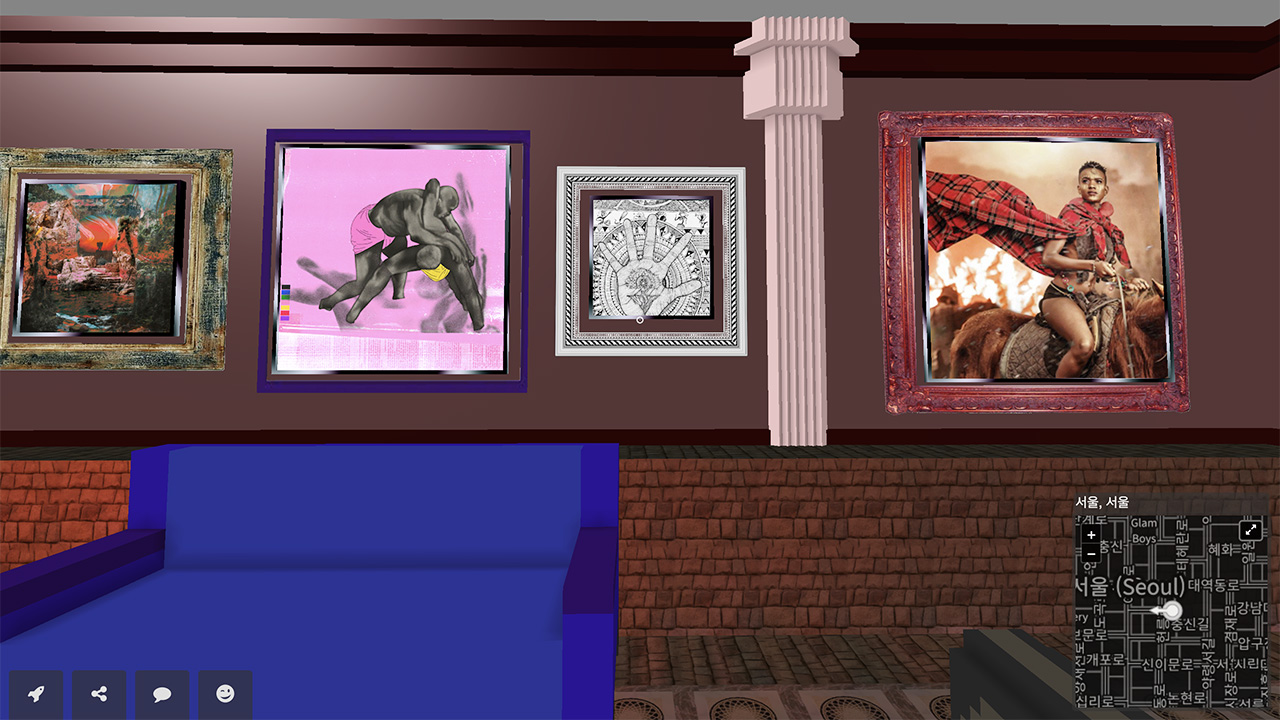As one of the few metaverse-spanning projects, the African Museum of the Metaverse (AMM) has an enviable virtual footprint. Since 2021, the museum has set up home in Decentraland, Voxels (previously CryptoVoxels), and The Sandbox, with plans underway to build in other metaverses including Matrix Worlds and Otherside. But it’s conceptually that the AMM makes its mark: it’s the first metaversal museum dedicated to showcasing work by artists from the African continent and its diaspora.
As a team member from Blacksanta.eth, the group of Black Web3 investors that masterminded AMM, tells us, “It’s only going to be there if you put it there.” Across its locations, the museum exhibits art held in the group’s collection — featuring names not limited to Vince Fraser, Idris Veitch, and AfroDroids by Owo — besides organizing community events and housing the Afro Metaverse Market that markets digital wearables. Come October 28, the AMM will host the Kenyan Metaverse Summit on its Decentraland plot, co-curating a virtual exhibition themed “Digital Renaissance.”

The multi-metaverse museum is integrated with teleportation, allowing visitors to travel to the AMM’s other locations in Somnium Space or Decentraland. Image: African Museum of the Metaverse in Voxels
The AMM has been built out and developed by Black-owned Metaverse development firm NFTNFTNFT.io, and includes teleportation, which allows participants to easily traverse AMM’s various locations and exhibitions. And that response has been striking: the museum continues to sit among the top 10 most visited venues in Voxels, reflecting the kind of demand for art and artists that remain underrepresented in the art meatspace. While meeting that appetite, the AMM is further carving a space for Black creators to thrive, to be visible, and to create impact.
Here’s more from Blacksanta.eth’s representative on AMM’s work in platforming Black creativity and onboarding the NFT community.
Why does the metaverse make for a good location for a museum?
It’s because you can offer these very different experiences and highlight different artists. You get to be more flexible: you can only have the Mona Lisa in one place, whereas you can have a NFT showing in four different worlds at the same time. The beauty of the metaverse is we could change the whole building tomorrow if we wanted to. Ultimately, it’s a more dynamic experience for attendees and artists alike, and that is something the traditional museums cannot replicate.

Located in Decentraland, Somnium Space, and Voxels, the Afro Market retails NFTs from projects such as CryptoRastas and AfroDroids. Image: African Museum of the Metaverse in Voxels
How do you see Web3 technologies like NFTs or the metaverse serving as a medium or platform for African or diasporic creators?
It’s a new medium, a new type of art that’s out there. I think it’s a good opportunity for folks to at least be exposed to artists that they otherwise wouldn’t. It’s all on the internet versus having to go to an auction house where, who’s even in that room in the first place? Who even knows how much is being sold? But the blockchain is open. You wouldn’t know what’s happening in the halls of high art traditionally, but with digital art, everybody can see everything. That will benefit folks who are naturally cut out of things. It’s a different medium at the end of the day, but the medium is the message.
Could you share the community element of the project, particularly the AMM’s partnerships with communities Black NFT Art and African NFT Community?
There is a large community of Black and African folks in the NFT world, but not as many from a metaverse perspective. So it’s bridging that gap between NFTs and metaverse. In Decentraland, for example, we have these three nine-story towers: the BNA Tower, the ANC tower, and Blacksanta.eth Plaza. The ANC tower is for the African NFT Community and BNA Tower for Black NFT Art, and their community headquarters are on the top two floors.
But because there are about six empty floors in each tower, they’re going to their community and opening up applications for these floors. Folks who apply to BNA with ANC get land for 24 months rent-free. It could be a project, an artist, or the Nigerian NFT community, but they can have their own metaverse headquarters in a communal decentralized world. It’s about onboarding folks into the metaverse, and providing access to a new dimension of community building and connection that is both immersive and borderless.

The AMM’s plot in Decentraland hosts communities including Black NFT Art and African NFT Community, enabling members to manage “metaverse headquarters in a communal decentralized world.” Image: African Museum of the Metaverse in Decentraland
How do you view such a project of onboarding people onto the metaverse?
There’s a big push to onboard people into NFTs, but I think the easiest way is to have them actually recognize why they want to do it. When people go to the African Museum of the Metaverse and they click a NFT, they see exactly who owns it and who created it, and it’s a museum experience that they like. They realize, “Oh, this is what NFTs could be.”
You can talk about the metaverse all you want — everyone’s afraid to click the link and not many people actually go. At the end of the day, just click the link, go see it and experience it. But you can’t do that unless you build something for them to see versus giving a lecture or classes on NFTs. When you see a museum and you see that you would actually spend time here, that’s when it clicks. It’s about giving people a reason to come to the metaverse.
What are some of AMM ongoing objectives?
There’s a lot going on; we almost want to build a Black Wall Street of the metaverse. We didn’t take a traditional path of having a Discord. We just approached it as, if you build it, they will come. A lot of projects are maybe built for the sake of community, but there’s enough communities. What they don’t have is places to go and things to do in the metaverse.

“It’s about onboarding folks into the metaverse, and providing access to a new dimension of community building and connection that is both immersive and borderless.” Image: African Museum of the Metaverse in Voxels
Any key learnings from managing a metaverse museum?
Frankly, a lot of us are wealthy and we don’t have to sell anything. We don’t sell tchotchkes, we don’t sell tickets, or anything at all for that matter — we’re just building because we feel it’s our responsibility with the amount of land and assets we have. We’re not even the ones building: we have commissioned NFTNFTNFT.io to construct each of our experiences.
For folks who are in that position holding onto a lot of land, I’d say go for it and build something that’s valuable. Don’t go in trying to commercialize it because it’s really not that very commercializable yet. For us, we’d rather be too early than too late; we were going to hold onto this land long-term even if we didn’t build on it. But if you think it’s going to get you rich quickly, I wouldn’t think that this is the place to go for that.



